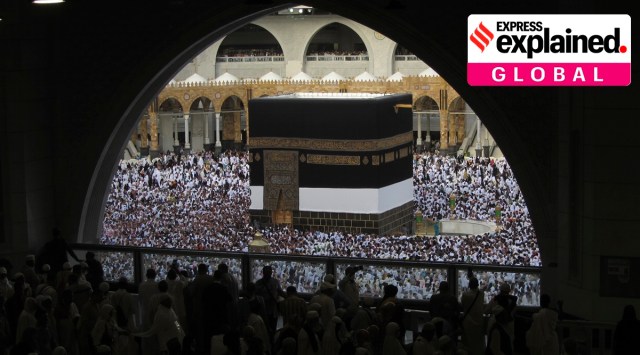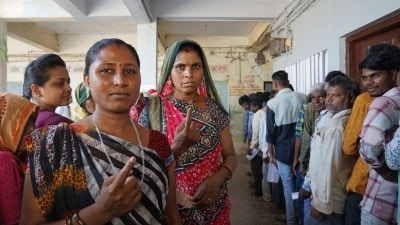- India
- International
Hajj pilgrimage begins: What is the Hajj quota and how is it allotted?
Given the vast scale of the Hajj pilgrimage, Saudi Arabia allots country-wise quotas which determine the total number of pilgrims who can make the journey from a particular country.
 Muslim pilgrims circumambulate around the Kaaba, the cubic building at the Grand Mosque, during the annual hajj pilgrimage in Mecca, Saudi Arabia, Monday, June 26, 2023, before heading to Mina in preparation for the Hajj, the fifth pillar of Islam and one of the largest religious gatherings in the world. (Photo: AP/PTI)
Muslim pilgrims circumambulate around the Kaaba, the cubic building at the Grand Mosque, during the annual hajj pilgrimage in Mecca, Saudi Arabia, Monday, June 26, 2023, before heading to Mina in preparation for the Hajj, the fifth pillar of Islam and one of the largest religious gatherings in the world. (Photo: AP/PTI) The Hajj pilgrimage began on Monday (June 26) with around 2.5 million Muslims from around the world expected to reach Mecca, Saudi Arabia, to circle Islam’s holiest site, the Kaaba. The religious gathering, one of the biggest in the world, takes place every year over six days during the 12th month of the Islamic calendar.
Given its immense scale, the pilgrimage poses a massive logistical challenge to Saudi Arabia. Housing, feeding and facilitating safe pilgrimages for millions of pilgrims who descend upon Mecca from across the world during a brief period of time is difficult, to say the least. Thus, the country allots country-wise quotas which determine the total number of pilgrims who can make the journey from a particular country.
How does the allotment of Hajj’s quota happen?
These quotas are broadly allotted on the basis of the number of Muslims that country has. According to a DW report, “the rule is around one pilgrim per every 1,000 Muslims in Muslim-majority countries. This is something that was agreed upon at the 1987 Organization of the Islamic Conference.”
For instance, Indonesia, which has the largest Muslim population in the world, at around 276 million Muslims, has been allowed to send just over 230,000 people for Hajj, the report added.
However, the quotas are also major diplomatic issues. Every year, countries lobby Saudi Arabia for more slots. After a Covid-19-related lull, the pilgrimage has resumed at its full scale in 2023.

India’s distribution of Hajj slots for pilgrims
Earlier this year, the Indian consulate in Jeddah, Saudi Arabia, tweeted that India signed the Haj 2023 bilateral agreement with Saudi Arabia. According to this, a total of 1,75,025 Indian Hajj pilgrims will be able to perform the Hajj, reportedly the highest in history.
Reports suggest that the way the system has traditionally worked is that the quota allotted to India (by Saudi Arabia) is then further distributed by the Ministry of Minority Affairs and the Haj Committee of India (HCoI) to various stakeholders.
According to the HCoI’s 2018-22 policy document, 70 per cent of India’s total quota goes to it and 30 per cent goes to private operators. While private operators are free to charge as they wish and take anyone who pays, the majority of pilgrims traditionally go through the HCoI, which runs a subsidised tour on behalf of the government (though the subsidy is being phased out).
Out of the total slots with the HCoI, 500 used to be held under the ‘Government discretionary quota’, whereas the rest were distributed to different states on the basis of their Muslim population, according to the 2018-22 policy. But the discretionary quota was abolished by the Centre in January this year and the seats were added back to the general pool.
Meanwhile, a draw of lots is conducted in each state to determine who makes the journey, in case the number of applicants exceeds the number of slots available.
More Explained
EXPRESS OPINION
May 07: Latest News
- 01
- 02
- 03
- 04
- 05








































